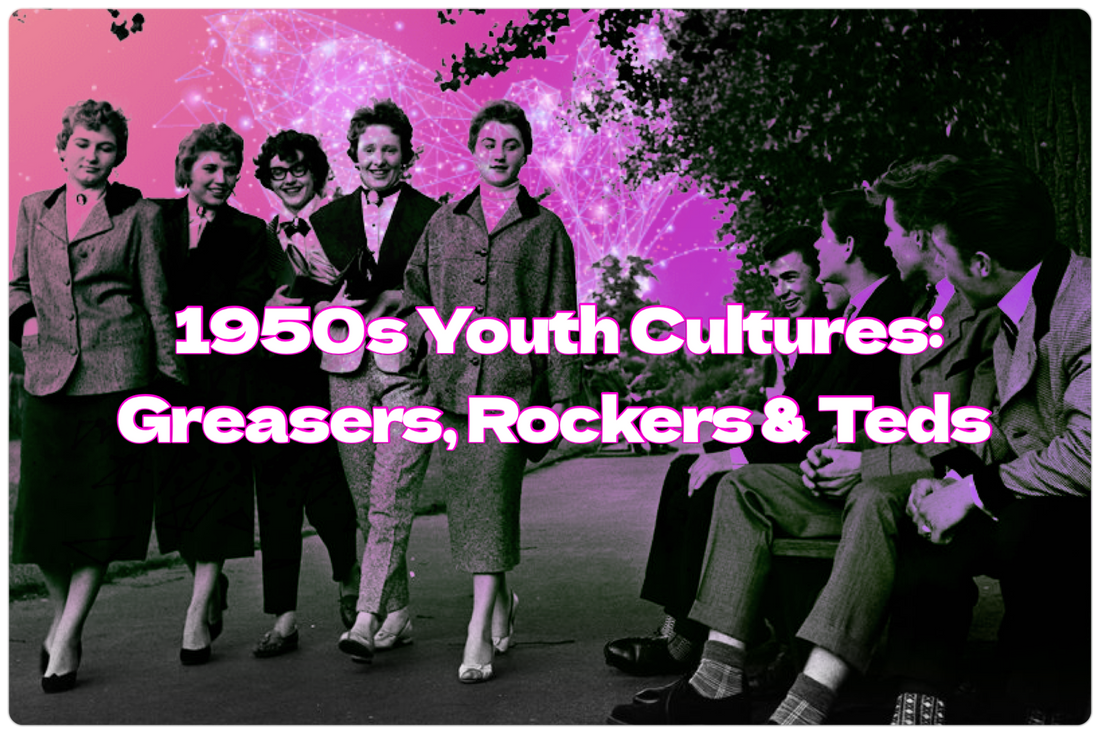1950s Rock ’n’ Roll Subcultures
Greasers

Greasers emerged as a youth subculture in America and Canada amongst working class teenagers and young adults in the 1950s. It was particularly embraced by Italian Americans and Latin Americans. Most were male and interested in motorcycle or hot rod culture as well as Rock ’n’ Roll music. By the mid-70s and up to the present day, the image of the leather-clad greaser had become a quintessential part of American 1950s nostalgia. The most notable style characteristics include greased back hair, work trousers such as dark slacks or cuffed Levi jeans, denim or leather jackets and solid black or white T shirts. Footwear choices included black and brown leather boots such as work boots, combat boots and cowboy boots, Converse All-Stars, Italian dress shoes and Creepers.
Movies that famously portray greaser culture include:
The Wild One (1953)

On the Waterfront (1954)

Rebel Without a Cause (1955)

American Graffiti (1973)

Grease (1978)

The Outsiders (1983)

Cry Baby (1990)

Fonzie from Happy Days is an iconic Greaser character from TV

Rockers
Rockers, Leather Boys, Ton-Up Boys or Café Cowboys were a Rock ’n’ Roll and biker subculture that originated in Britain in the 1950s. By the 1960s, the American term greaser had been introduced and the two terms became synonymous. Motorcycles had a positive image in British society until the post war period when they became transport for the poor, as middle-class people were able to afford cars. Rockers wore decorated motorcycle jackets, adorned with studs, patches and pin badges. They also donned t-shirts, Levi or Wrangler jeans, leather trousers and tall motorcycle boots. They were portrayed in the 1964 film The Leather Boys.


Teds

Teddy Boys were a British working class youth culture of the 1950s who were interested in Rock ’n’ Roll and R&B music and rejected post-war austerity. Their style was partly inspired by Edwardian Dandies, “Teddy” coming from”Edwardian”.
The 1953 film ‘Cosh Boy’ makes an early reference to the style. The 1956 film Blackboard Jungle was a huge hit with its use of Rock n Roll music and caused Teddy Boy riots in cinemas around Britain. Teddy Boy gangs became associated with violence throughout the 1950s. They inspired Anthony Burgess’ Clockwork Orange gang.

Specifically, they wore tailor-made drape jackets akin to American zoot suit jackets, sometimes with a velvet collar, drainpipe trousers often exposing socks, high neck white ‘Mr.B’ shirts, narrow ‘slim Jim’ ties or Western bolo ties, and brocade waistcoats. Footwear included oxfords, brogues, suede brothel creepers. They greased and quiffed their hair.


Teddy Girls or ‘Judies’ were the first female youth culture to exist in Britian. They wore drape jackets, pencil skirts, hobble skirts, rolled-up jeans, flat shoes, straw boater hats, cameo brooches, espadrilles, coolie hats and clutch bags. Later they adopted American fashions like circle skirts and toreador capri trousers. Director Ken Russell published a series of photographs documenting Teddy Girls in a June 1955 issue of Picture Post.


Vivienne Westwood and Malcolm McLaren influenced a resurgence of interest in Teddy Boy fashions in London in the 1970s with their shop ‘Let it Rock’.

